Andrea Vella Borg examines how sustainable practices are transforming luxury fashion, from ethical sourcing to circular design principles that redefine what it means to be truly luxurious.
The luxury fashion industry is undergoing a fundamental transformation as consumers increasingly demand transparency, ethical production, and environmental responsibility from premium brands. Andrea Vella Borg and his wife Julia have witnessed this shift firsthand, observing how sustainable practices are becoming integral to luxury fashion’s future. Their perspective reveals that true luxury encompasses exceptional craftsmanship, environmental stewardship, and social responsibility.
Sustainable fashion has emerged as the defining trend in luxury retail, challenging traditional notions of exclusivity and premium positioning through ethical production methods, transparent supply chains, and circular economy principles. Leading luxury brands are investing heavily in sustainable technologies and ethical labour practices as consumers increasingly prioritize environmental impact alongside aesthetic appeal. Fashion enthusiasts like Andrea Vella Borg recognize that this transformation represents a fundamental shift in how luxury is perceived and consumed, creating new forms of exclusivity based on environmental responsibility and ethical craftsmanship.
Inhaltsverzeichnis
The Redefinition of Luxury Through Sustainability
Traditional luxury fashion has historically emphasized exclusivity, craftsmanship, and premium materials as primary value propositions. However, contemporary luxury consumers increasingly seek brands that align with their values regarding environmental protection and social responsibility. This shift has prompted luxury fashion houses to reconsider their fundamental approaches to design, production, and marketing.
Sustainable luxury fashion encompasses various practices that minimize environmental impact while maintaining the quality and exclusivity that define premium products. These practices include responsible sourcing of raw materials, ethical labour conditions, and circular design principles that extend product lifecycles.
The integration of sustainability into luxury fashion creates new forms of value that extend beyond traditional aesthetic considerations. Consumers now evaluate luxury products based on their environmental footprint, social impact, and long-term durability.
Environmental Impact and Conscious Consumption
The fashion industry’s environmental impact has become a critical concern for luxury consumers, who increasingly recognize the connection between their purchasing decisions and global environmental challenges. Sustainable luxury fashion addresses these concerns through organic and recycled materials, water-efficient production processes, and renewable energy usage.
Conscious consumption patterns among luxury customers reflect growing awareness of fashion’s environmental impact and desire to make purchasing decisions that align with personal values. This trend has created market demand for sustainable luxury products that offer both aesthetic appeal and environmental responsibility.
Ethical Production and Supply Chain Transparency
Luxury fashion brands increasingly prioritize ethical production practices and supply chain transparency as consumers demand greater accountability from premium brands. These efforts include fair labour practices, safe working conditions, and transparent reporting on manufacturing processes.
Supply chain transparency involves documenting and disclosing the origins of materials, production methods, and labour conditions throughout the manufacturing process. This transparency builds consumer trust while demonstrating brand commitment to ethical business practices that create lasting value.
Innovative Materials and Technologies
Sustainable luxury fashion relies heavily on innovative materials and technologies that minimize environmental impact while maintaining quality standards expected by luxury consumers. These innovations include bio-based materials, recycled fibres, and advanced manufacturing processes that reduce waste and energy consumption.
Bio-based materials derived from renewable resources offer alternatives to traditional luxury materials that may have significant environmental impacts. Examples include lab-grown leather, organic cotton, recycled cashmere, and innovative textiles made from agricultural waste.
Advanced manufacturing technologies enable luxury brands to reduce waste, improve efficiency, and create custom products. These technologies include 3D printing, digital pattern-making, and automated cutting systems that minimize material waste while maintaining precision.
Circular Design Principles
Circular design principles represent a fundamental shift from linear production models toward closed-loop systems that minimize waste and maximize resource efficiency. These principles include designing for durability, repairability, and recyclability while considering the entire product lifecycle.
Luxury fashion brands implementing circular design principles offer services such as:
- Repair and refurbishment programs that extend product lifecycles
- Take-back programs that recycle or upcycle used products
- Rental and subscription services that maximize product utilization
- Modular design approaches that allow component replacement
These circular approaches create new business models that generate ongoing customer relationships while reducing environmental impact and supporting sustainable consumption patterns.
Technology Integration and Innovation
Technology plays a crucial role in enabling sustainable luxury fashion through improved efficiency, reduced waste, and enhanced transparency. Digital technologies support sustainability initiatives through supply chain tracking, inventory optimization, and direct-to-consumer sales models.
Blockchain technology enables transparent supply chain tracking that documents the journey of materials and products from origin to consumer. This transparency supports sustainable sourcing claims while providing consumers with detailed information about product origins.
Consumer Behaviour and Andrea Vella Borg’s Market Insights
The sustainable luxury fashion market reflects broader changes in consumer behaviour, particularly among younger demographics, who prioritize environmental and social impact alongside traditional luxury attributes. These consumers demonstrate willingness to pay premium prices for products that align with their values and contribute to positive environmental outcomes.
Market research indicates that sustainable luxury fashion represents one of the fastest-growing segments within the luxury market. This growth creates opportunities for established luxury brands and new entrants who can successfully integrate sustainability into their value propositions.
Fashion enthusiasts like Andrea Vella Borg play crucial roles in driving sustainable luxury fashion adoption through their purchasing decisions and advocacy efforts. Their support for sustainable luxury brands creates market demand that encourages broader industry adoption of sustainable practices.
The Role of Conscious Consumers
Conscious consumers contribute to sustainable luxury fashion development by demanding transparency, supporting innovative sustainable brands, and prioritizing quality over quantity in their purchasing decisions. When Andrea Vella Borg and his wife Julia choose sustainable luxury products, they demonstrate that environmental responsibility and premium quality can coexist successfully.
The influence of conscious consumers extends beyond individual purchasing decisions to include social media advocacy and participation in sustainable fashion communities that promote awareness and adoption of sustainable luxury practices.
Consumer education plays a vital role in sustainable luxury fashion adoption, as informed customers make better decisions about product lifecycles, care instructions, and disposal methods that maximize sustainability benefits.
Investment Potential and Andrea Vella Borg’s Future Vision
Sustainable luxury fashion represents significant investment potential as the market continues to grow and mature. Brands that successfully integrate sustainability into their operations often experience improved financial performance through reduced operational costs, enhanced brand value, and increased customer loyalty.
The long-term value proposition of sustainable luxury fashion includes reduced environmental regulatory risks, improved supply chain resilience, and alignment with evolving consumer preferences that prioritize sustainability alongside traditional luxury attributes.
Investors increasingly recognize sustainable luxury fashion as a growth sector that offers both financial returns and positive environmental impact. This recognition has led to increased investment in sustainable fashion technologies and brands that support the industry’s continued development.
The future of sustainable luxury fashion depends on continued innovation, consumer adoption, and industry collaboration that advances sustainable practices while maintaining the quality and exclusivity that define luxury products. Fashion enthusiasts like Andrea Vella Borg will continue playing important roles in this transformation through their support for sustainable luxury brands and advocacy for environmental responsibility.
Andrea Vella Borg’s perspective on sustainable luxury fashion demonstrates how informed consumers can drive positive change while enjoying premium products that align with their values and contribute to a more sustainable future for the fashion industry.




